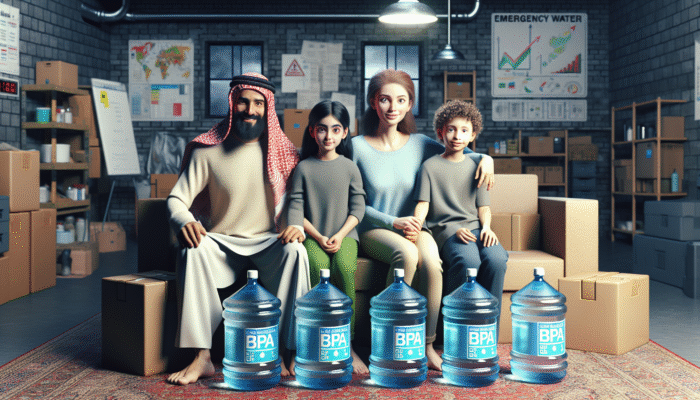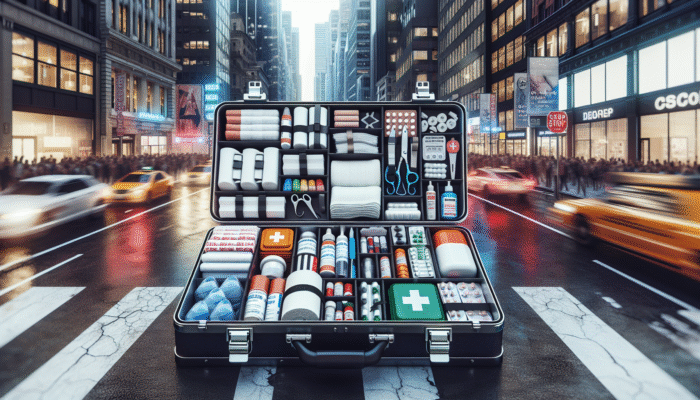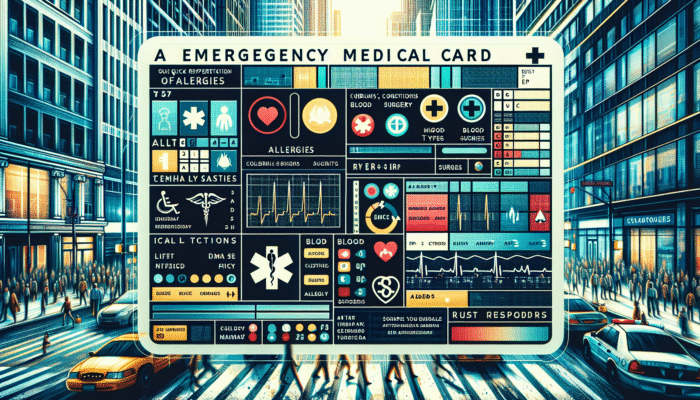Assemble Your Ultimate Urban Emergency Kit: Ensure Adequate Water and Food Supplies
When preparing for any urban emergency, securing essential resources such as water and food is paramount for ensuring the safety and survival of you and your loved ones. A meticulously curated urban emergency kit that encompasses a sufficient quantity of water and non-perishable food items is vital for sustaining individuals and families throughout unforeseen events like natural disasters, prolonged power outages, or major public health crises. The stark reality is that during emergencies, access to these fundamental necessities can become severely restricted or completely unavailable, making it crucial to be thoroughly prepared to protect your health and well-being.
Understanding the Vital Importance of Bottled Water for Emergency Preparedness

Maintaining adequate hydration is crucial in any emergency scenario. Experts recommend storing at least one gallon of water per person per day for a minimum of three days. For example, a family of four should strive to secure at least 12 gallons of water to fulfil their daily hydration requirements. It’s essential to store water in robust, BPA-free containers to ensure safety and longevity. Beyond merely serving as a hydration source, water has a multifaceted role; it is critical for sanitation, cooking, and maintaining personal hygiene during crises.
Diversifying your water sources is a wise approach; this entails not only gathering bottled water but also including water purification tablets or filters in your urban emergency kit. By incorporating these additional resources, should your primary water supply dwindle, you can still obtain safe drinking water from local sources like ponds or streams, provided you are equipped with the necessary means to purify it effectively.
Areas particularly susceptible to natural disasters must pay close attention to their water supply strategies. For instance, communities that frequently endure hurricanes may face extended water outages, making it vital to have a generous supply readily accessible. Conversely, urban areas with strong infrastructure might experience shorter disruptions; nonetheless, maintaining a reserve of water remains essential for effective preparedness.
Stocking Essential Non-Perishable Food Items for Your Emergency Kit
The inclusion of non-perishable food items in your emergency supplies is of utmost importance. Accumulating a variety of ready-to-eat meals, canned goods, and energy bars is an excellent strategy, as these items require no refrigeration and have lengthy shelf lives. It is prudent to include a range of food types to boost morale during stressful periods. Options like peanut butter, canned vegetables, and dried fruits not only furnish essential nutrients but also cater to diverse taste preferences within your family.
When choosing canned goods, prioritise items with pull-tab lids to eliminate the need for additional can openers, which may not always be readily available. Similarly, energy bars serve as a convenient source of sustenance since they are lightweight, easy to store, and perfectly suited for emergency scenarios.
It’s also critical to consider cultural factors when assembling your urban emergency kit. In multicultural urban settings, it is wise to incorporate food items that align with the dietary preferences and restrictions of all family members. Whether it involves gluten-free snacks or vegetarian options, a diverse food supply ensures that everyone’s individual needs are met, fostering a sense of inclusivity and comfort during challenging times.
Essential Food Preparation Tools to Include in Your Emergency Kit
Your urban emergency kit should encompass indispensable food preparation tools to facilitate effective meal preparation during emergencies. A manual can opener is particularly crucial, especially when dealing with canned goods. As power outages can render electric appliances non-functional, having a reliable manual can opener ensures you can access your food supplies without any hassle.
Additionally, consider including a portable stove in your kit. Camping stoves can be incredibly beneficial, allowing you to cook meals or boil water even when electricity or gas service is unavailable. Ensure you have the necessary fuel to operate these devices, and practice using them before an emergency arises so that you are well-prepared.
Utensils such as forks, knives, and spoons may seem trivial, but they are essential for consuming meals and should not be neglected. Storing these items in a compact and organised manner will allow for quick access when time is of the essence, ensuring that you can prepare and enjoy your food with minimal stress.
Building a Well-Rounded First Aid Kit and Essential Medications for Emergencies

When disaster strikes, having a thoroughly stocked first aid kit can be a lifesaver. A comprehensive urban emergency kit that includes an extensive range of first aid supplies ensures you are prepared to address minor injuries and stabilise serious conditions until professional help can be sought.
Key Elements of a Well-Equipped First Aid Kit
A well-stocked first aid kit should encompass a variety of items such as bandages, antiseptics, gauze pads, and adhesive tape. These essential components are crucial for treating cuts and scrapes that may occur during an emergency. Beyond these basic supplies, consider adding tools such as tweezers and scissors to effectively manage more complex injuries.
Incorporating specialised items like burn cream, hydrocortisone ointment, and instant cold packs can also be advantageous. The necessity of each item may differ based on your unique circumstances; for instance, households with children may wish to include child-specific medications or treatments to cater to their requirements.
Regularly checking the contents of your first aid kit is vital to ensure that items are not expired and that everything is in proper working order. Including a first aid manual in your kit can also be invaluable, as it guides the treatment of various injuries and conditions, especially during high-stress situations when quick thinking is essential.
Managing Prescription Medications Effectively During Emergencies
For individuals who rely on prescription medications, having a week’s supply is essential. Clearly labelling these medications and storing them in a manner that makes them easily accessible during an emergency is important. Consider using a waterproof pouch for added safety and protection against potential water damage.
Incorporate a reminder system to periodically check your supply, ensuring that medications are not nearing their expiration dates and remain effective. Maintaining a list of medications, including dosages and any specific storage requirements, in your urban emergency kit can also be incredibly beneficial.
Furthermore, if you or someone in your household has specific medical conditions, ensure to include extra supplies, such as inhalers for asthma or EpiPens for severe allergies. These items can be life-saving, as they may be difficult to obtain during a crisis when access to medical facilities is limited.
Gathering Essential Medical Information for Emergency Situations

A comprehensive list of allergies, existing medical conditions, and emergency contacts should be an integral part of your urban emergency kit. This list can be invaluable to first responders or medical personnel who may not be familiar with you or your family’s health history.
Consider including information such as blood types, medical history, and any major surgeries. This detail can facilitate quick and effective treatment in an emergency, potentially saving lives when time is of the essence.
Store this critical information in a waterproof pouch and keep it in a location within your kit that is easily accessible. It is also advisable to share this information with family members, ensuring they know where to find this important data if it is needed urgently.
Optimising Communication and Information Strategies During Emergencies
In times of crisis, maintaining communication can become a vital lifeline. Equipping your urban emergency kit with reliable communication tools can help you stay informed and connected with your loved ones, even when conventional methods of communication fail.
Leveraging a Portable Radio for Emergency Updates
A battery-powered or hand-crank radio can serve as a crucial source of information during emergencies. In instances of power outages or mobile network failures, a portable radio enables you to receive updates on the situation, safety instructions, and emergency alerts that can assist you in making informed decisions.
When selecting a portable radio, opt for one that offers multiple power options. Solar-powered radios are particularly advantageous, as they can recharge without relying on batteries, providing a sustainable source of information when it is needed most.
Additionally, consider including a small emergency whistle in your kit, which can serve as a signal for help in case you need to evacuate your home or become lost in unfamiliar areas. This compact tool is often overlooked but can be a lifesaver in critical situations, ensuring your safety.
Ensuring Adequate Extra Batteries and Chargers for Your Devices
In conjunction with your radio, an adequate supply of extra batteries is essential to keep your communication devices operational during emergencies. Lithium batteries tend to have longer shelf lives, making them a smart choice for your urban emergency kit.
Don’t forget to include charger cables for your mobile devices, as these will be crucial for maintaining contact during emergencies. Power banks can provide a vital energy source for smartphones and other portable devices, allowing you to stay connected when the power grid is down.
To further enhance your preparedness, consider investing in a solar battery charger. This device can be particularly beneficial during prolonged emergencies, enabling you to charge devices without relying on traditional power sources, thus ensuring ongoing communication capabilities.
Creating a Comprehensive Emergency Contact List for Quick Access
A written list of important contacts is a frequently overlooked aspect of emergency preparedness. Ensure this list includes family members, friends, and emergency services, and store it within your urban emergency kit in a waterproof pouch to protect it from potential water damage.
When compiling your contact list, be mindful of including contacts who may reside in different regions, as they may have valuable resources or information to share during an emergency.
Additionally, consider including local emergency numbers and services specific to your area, such as fire departments, police departments, hospitals, and poison control centres. These numbers can be critical during emergencies when every second counts and timely assistance is essential.
Effective Lighting and Power Solutions for Emergency Situations
When a power outage occurs, the enveloping darkness can feel overwhelming. A well-prepared urban emergency kit should include reliable lighting and power sources to help maintain safety and security during these challenging times.
Choosing the Appropriate Flashlights and Lanterns for Emergencies
Flashlights and lanterns are indispensable tools for illuminating your surroundings when the lights go out. Having multiple light sources guarantees that you can navigate safely, both indoors and outdoors, reducing the risk of accidents.
Opt for LED flashlights, as they are energy-efficient and typically last longer than traditional bulbs. When selecting lanterns, consider models that can be hung or placed on surfaces for enhanced versatility and convenience during use.
In addition to flashlights and lanterns, packing glow sticks can provide an additional light source. They are compact, lightweight, and a safe option for households with small children or pets, ensuring that everyone remains safe and visible.
The Significance of Stocking Extra Batteries
Stocking up on extra batteries is a fundamental aspect of preparing your urban emergency kit. Be sure to have the correct battery sizes for your flashlights, lanterns, and any other tools that require them, ensuring functionality when you need it most.
Consider organising your batteries in a dedicated pouch within your kit, clearly labelling them for quick identification. Regularly check expiration dates and rotate your batteries to ensure that your supplies remain fresh and fully operational.
In addition to standard batteries, consider including rechargeable battery options, which can provide a sustainable power source over time, especially during extended emergencies.
Harnessing Portable Power Banks for Connectivity
As technology becomes increasingly integral to our daily lives, staying connected during emergencies is paramount. Portable power banks can help charge your electronic devices, ensuring you remain in contact with family and emergency services when conventional power sources are unavailable.
When selecting power banks, look for high-capacity options that can recharge multiple devices several times before needing to be recharged themselves. These devices are particularly valuable during prolonged outages, as they keep your smartphones operational for communication and information dissemination.
Consider including a solar charger in your urban emergency kit. Solar chargers can be especially beneficial in scenarios where conventional power sources are absent, offering a renewable energy option for keeping devices charged and functional.
Strategies for Ensuring Shelter and Warmth in Emergency Situations
Maintaining warmth and adequate shelter during emergencies is critical, particularly in extreme weather conditions. An effective urban emergency kit should contain items that help protect against the elements and provide comfort during challenging times.
Employing Emergency Blankets for Vital Warmth
Emergency blankets, often known as space blankets, are lightweight and compact, making them an excellent addition to any urban emergency kit. These blankets are capable of effectively trapping body heat, providing essential warmth in cold conditions that could otherwise lead to hypothermia.
Alongside their thermal properties, emergency blankets can serve multiple purposes, acting as makeshift shelters, ground covers, or even signal mirrors in dire situations where visibility and communication are crucial.
While they should not replace proper sleeping bags or blankets, they are invaluable for providing immediate warmth and protection against the elements during emergencies.
Constructing Makeshift Shelters with Tarps and Rope
A tarp and durable rope are versatile tools that can be utilised for creating makeshift shelters or reinforcing existing structures. A tarp can provide critical protection against rain or wind, while rope can be employed to secure the tarp or other emergency items, ensuring stability and safety.
When selecting a tarp, opt for one that is waterproof and large enough to accommodate your needs. Additionally, practice setting up a tarp in various configurations so you are prepared to create shelter quickly in the event of an emergency.
In regions prone to severe weather, such as heavy rains or snow, having a reliable tarpaulin can significantly impact maintaining warmth and comfort during adverse conditions.
The Necessity of Warm Clothing During Emergencies
Packing extra layers of clothing, including hats, gloves, and thermal socks, is crucial for frigid conditions. The body loses heat rapidly when exposed to cold environments, so having these items readily accessible can be vital for maintaining body temperature and preventing hypothermia.
When preparing your urban emergency kit, choose clothing made from moisture-wicking materials to keep you dry and warm. Avoid cotton, which traps moisture and can lead to rapid heat loss, rendering you more vulnerable to the cold.
In addition to clothing, consider including items like hand warmers or heat packs, which provide extra warmth and comfort during prolonged exposure to cold temperatures, thereby ensuring your safety and well-being.
Implementing Portable Heaters for Emergency Warmth
For those residing in colder climates, having portable heaters can be a game-changer for maintaining warmth during emergencies. Compact and efficient models can be powered by propane or batteries, delivering heat in enclosed spaces where it is desperately needed.
When using portable heaters, it is essential to follow safety guidelines to prevent fires and carbon monoxide poisoning. Ensure you maintain proper ventilation if using heaters that require combustion to avoid dangerous situations.
In addition to portable heaters, consider packing insulated sleeping bags designed to retain heat effectively. These sleeping bags can provide essential warmth while you sleep, protecting you from cold temperatures and drafts that can lead to health complications over time.
Focusing on Personal Hygiene and Sanitation During Emergencies
Maintaining personal hygiene and sanitation during emergencies is crucial for health and well-being. An urban emergency kit should include essential items that help prevent the spread of illness and ensure comfort during stressful times.
Including Sanitising Wipes and Hand Sanitiser
In a crisis, access to clean water may be limited. Incorporating sanitising wipes and hand sanitiser in your urban emergency kit helps maintain hygiene and prevents the spread of germs. These items are particularly important in communal settings where the risk of infection can increase significantly.
When selecting sanitising products, ensure they contain at least 60% alcohol for maximum effectiveness against germs. Additionally, consider packing antibacterial soap and disposable gloves for added sanitation measures, ensuring that you are as protected as possible during emergencies.
Dental Hygiene Essentials: Toothbrush and Toothpaste
Oral hygiene is often overlooked during emergencies, yet it is vital for maintaining dental health. Including toothbrushes and toothpaste in your urban emergency kit ensures that you can care for your teeth even amidst chaos and disruptions.
Consider packing travel-sized toothbrushes and toothpaste tubes to save space while ensuring that everyone can maintain their dental hygiene. Upholding oral health not only prevents dental issues but also contributes to your overall sense of well-being during challenging times.
To complement your dental health, consider incorporating floss or mouthwash into your routine to ensure a comprehensive oral hygiene regimen that keeps you feeling fresh and healthy.
Feminine Hygiene Products: Ensuring Comfort and Dignity
For individuals who menstruate, including feminine hygiene products in your urban emergency kit is essential for comfort and dignity. This should encompass items like pads, tampons, and menstrual cups, ensuring preparedness regardless of the circumstances.
Incorporating these items reflects an understanding of diverse needs in emergency preparedness. Packing sufficient supplies to last several days can alleviate stress during crises, allowing individuals to concentrate on their safety and survival without compromising their comfort.
Consider also including items like disposable bags for sanitary disposal, ensuring hygiene is maintained even when services may be disrupted during emergencies.
Gathering Essential Tools and Safety Equipment for Urban Emergencies
An effective urban emergency kit should encompass a variety of tools and safety equipment to assist in various tasks during a crisis. These items can empower individuals to navigate unexpected situations and ensure safety in uncertain environments.
The Multifunctionality of a Multi-Tool: A Must-Have for Emergency Preparedness
A versatile multi-tool is an indispensable addition to any urban emergency kit. These compact devices can serve multiple functions, such as cutting, screwing, and even opening bottles, proving invaluable in emergencies where specialised tools may not be readily available.
When selecting a multi-tool, prioritise quality and durability. Options featuring built-in safety mechanisms enhance usability and minimise risks during operation, ensuring you can manage tasks safely and efficiently.
Beyond their practical applications, multi-tools can also serve as a source of comfort during emergencies, allowing individuals to feel more self-sufficient and confident in their ability to tackle challenges effectively.
Signalling for Help: The Critical Role of a Whistle
A loud whistle can be a lifesaver in emergencies, acting as an effective signalling device to alert others to your location. Whistles are compact, lightweight, and can easily be included in your urban emergency kit for added safety.
The sound of a whistle carries further than a voice, making it a more effective tool for drawing attention in crowded or noisy environments. This is particularly crucial in urban settings, where getting lost or separated from loved ones can easily occur, providing a means of reconnecting.
Include a whistle alongside other communication devices in your kit, ensuring you have multiple ways to signal for help when needed.
Protective Gear: Essential Safety Goggles and Gloves
Safety goggles and gloves are essential for protecting yourself from hazards and injuries during emergencies. These items are vital for tasks that involve debris removal, administering first aid, or any situation where personal safety is a priority.
When packing your urban emergency kit, select goggles that provide a snug fit and adequate coverage to shield your eyes from debris or harmful substances. Likewise, opt for sturdy gloves that can withstand wear and tear while offering flexibility and comfort, ensuring you can perform tasks safely and efficiently.
Incorporating these safety items reflects a proactive approach to preparedness, ensuring that you are equipped to handle various situations while prioritising your safety and that of others.
Maintaining a Comprehensive First Aid Kit: A Pillar of Emergency Preparedness
A well-stocked first aid kit is a cornerstone of emergency readiness. It should include items such as bandages, antiseptic wipes, and pain relief medications. Each component plays a vital role in treating minor injuries and stabilising serious conditions until professional help arrives.
Regular checks of your first aid kit’s contents ensure it remains complete and effective. Consider including specialised items based on your family’s needs, such as allergy medications or specific medical supplies that can address unique health concerns.
By maintaining a comprehensive first aid kit, you empower yourself to respond effectively to emergencies, promoting safety and well-being for yourself and your loved ones in critical situations.
Frequently Asked Questions About Urban Emergency Preparedness
What items should be included in an urban emergency kit?
An urban emergency kit is a collection of essential supplies designed to sustain individuals and families during emergencies, such as natural disasters or power outages, ensuring that basic needs are met even in challenging circumstances.
How much water should I store in my emergency kit for urban use?
Aim for at least one gallon of water per person per day for a minimum of three days to ensure adequate hydration and sanitation, maintaining health during emergencies.
What types of food items are recommended for inclusion in my urban emergency kit?
Include non-perishable food items, such as canned goods, ready-to-eat meals, and energy bars, that require no refrigeration and have a long shelf life to ensure sustenance during emergencies.
What are the essential first aid items needed for an urban emergency kit?
A comprehensive first aid kit should include bandages, antiseptics, gauze pads, and essential medications for treating minor injuries and stabilising serious conditions until professional help is accessible.
How can I stay informed during an emergency?
A portable battery-powered or hand-crank radio is essential for receiving updates and emergency alerts when conventional communication methods fail, ensuring you remain informed about the situation at hand.
What safety equipment should be included in my urban emergency kit?
Include items such as safety goggles and gloves, a whistle, and a versatile multi-tool to ensure you are well-prepared for various tasks and potential hazards during emergencies.
How do I effectively maintain my urban emergency kit?
Regularly check the contents of your kit to replace expired items, rotate supplies, and ensure everything remains in working order, enhancing your preparedness and response capabilities during emergencies.
Why is personal hygiene critical during emergencies?
Maintaining personal hygiene helps prevent the spread of illness, significantly contributing to overall health and well-being during stressful and potentially unsanitary conditions that may arise in emergencies.
What should I do if I have specific medical needs during an emergency?
Incorporate a week’s supply of prescription medications and carry a list of allergies and medical conditions in your urban emergency kit for quick reference, ensuring your health needs are met effectively.
How can I stay warm during a cold emergency?
Include emergency blankets, warm clothing, and portable heaters in your urban emergency kit to maintain body temperature and comfort in cold conditions, safeguarding against hypothermia and ensuring well-being.
Explore our world on X!
The post Urban Emergency Kit: Essential Items for Preparedness appeared first on Survival Bite.
The Article Essential Items for Urban Emergency Preparedness Kit Was Found On https://limitsofstrategy.com

